

A Look At The Westbury Quilt
July 31, 2024

Hi!
This week I thought I’d share a bit more detail on my new favourite ‘old’ quilt, so let’s take a look at the wonderful colonial Australian Westbury Quilt!
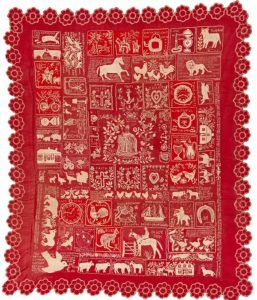
Known as The Westbury Quilt, this stunning hand embroidered and appliqued red and white quilt was made by 6 women from the Hampson family between 1900-03 in Tasmania, Australia.
It is one of the more important colonial quilts in the collection of the National Gallery of Australia, and was recently featured in their “A Century of Quilts” exhibition in Canberra.
Although technically more of a coverlet, as it is not quilted, this quilt has 52 stitched blocks – embroidered with proverbs and sayings, and intertwined with blocks depicting favourite farm animals, complete with pet names! It’s a joyful quilt, with its bright red fabric, and funny (laugh out loud at times) sayings, and a big happy embroidered floral border.
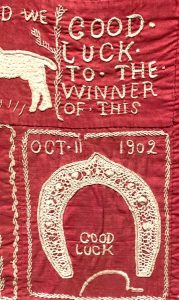
It is likely that this quilt was intended as a raffle prize at the time, due to the embroidery on the block above, but the quilt was exhibited by Mary Hampson at the Westbury Agricultural Show in 1904 and again at another in 1906.
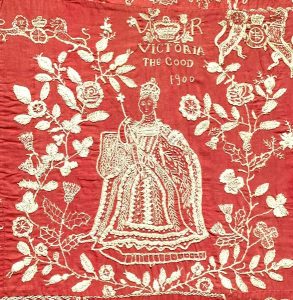
The image of Queen Victoria is central in this quilt, and she is surrounded with a garland of flowers including the Tudor rose, shamrock and thistle signifying her rule over England, Ireland and Scotland. The British Coat of Arms also appears, as does the British lion.

The blocks show a wonderful assortment of different farm animals, and I think many of these sayings are still relevant today.
(Some of these Westbury Quilt blocks are sideways, and a few are upside down. These lovely stitched flowers run all around the border too.)
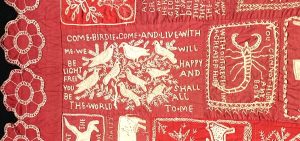
Some are sweet – ‘Come birdie come and live with me. We will be happy light and free. You shall be all the world to me.’
And others downright practical (with emu) …
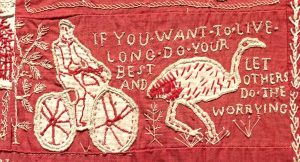
There’s a touch of whimsy –
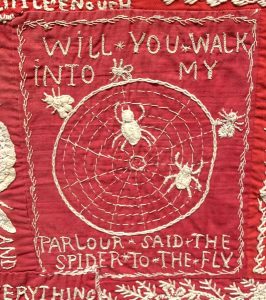
And some very appealing quirkiness –
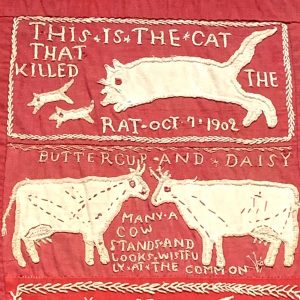
Who wouldn’t fall in love with Bobs the kangaroo, or Polly and Kitty the sheep?
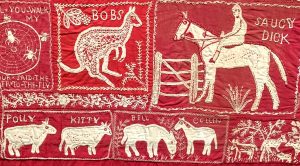
And then there’s the funny blocks:
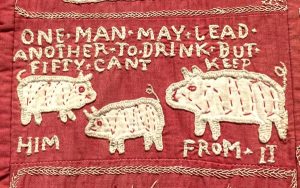
And one of my favourites – (and it’s even underlined for emphasis! 🙂 )
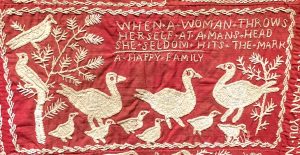
I hope you enjoyed this brief look at a truly wonderful Australian quilt, and you’ll find more early colonial Australian quilts in an article on this recent exhibition, in our August Online Quilt Magazine (out soon).
Enjoy your week, and please let us know below if you enjoyed any of these Westbury Quilt blocks in particular!

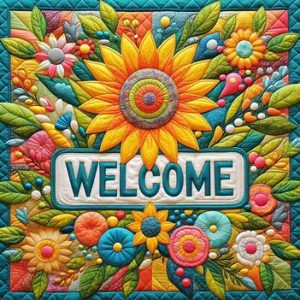

Will you walk into my parlour said the spider to the fly.
This was written by my great, great, great grandmother Mary Howitt.
Wow! How amazing. That’s a claim to fame, for sure. It was lovely to see it on this quilt too.
thank you for this peek at the Westbury Quilt! lovely
So many wonderful quotes that we all should try to live by. I love the humour which we all need to keep life in balance.
Anyone who is interested in the Westbury quilt may be interested in the article I wrote for the Tasmanian Historical Research Association (see https://thra.org.au/). (Sharples, R. (2024), “The Westbury Quilt”, Papers and Proceedings: Tasmanian Historical Research Association Vol. 71, No 2, August: pp. 41-47) . This is not up on the Internet yet, but it will be eventually. In the meantime, hard copies are available from the THRA. I wrote an abstract:
The Westbury quilt is a counterpane that was produced by members of the Hampson family in the Westbury, Tasmania, area at the beginning of the twentieth century. The quilt has white embroidery and applique on a red background. It shows objects which, presumably, were important to the women who constructed it, including their homes and items related to their daily life, domestic and farm animals, references to music, bicycles, biblical quotations and mottos that were significant. Some items appear to be related to the British Empire, including a picture of Queen Victoria and other elements which may refer to the Boer War. Different fabrics, the use of several fonts for the text and both simple and elaborate stitching are indications of the possible involvement of several different women in the construction of the quilt. Many of the motifs are unexplained but would probably have been obvious to the family.
P.S. this quilt was completed AFTER federation (i.e. after 1901) so it’s not colonial.